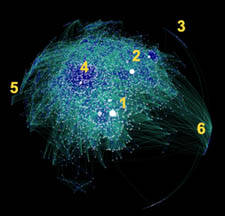
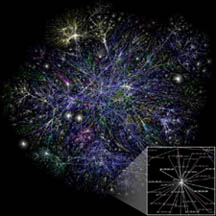
Steve Prentice, analyst for Gartner Research, very kindly talked to me on Skype from the Symposium/ITexpo in San Francisco, yesterday. Of course, I asked about his controversial prediction, “the majority of active Internet users and major enterprises will find value in participating in this area [Virtual Worlds] in the coming years.” And:
By 2011, 80% of active Internet users (and Fortune 500 enterprises) will have a “second life” – but not necessarily IN “Second Life.”
Metaversed and others have found this “way off the mark.” But, “Things always happen sooner that people think,” was Steve’s response. And, I had just spent most of the day watching the amazing Gapminder.org videos of Hans Rosling (presented at TED – see TED blog), so I was definitely in the mood to agree.
When dealing with world scale development on issues like poverty, global health, or even the rate of growth of a developing world like Second Life it is very hard to get a handle on events that occur on this kind of massive scale. The amazing, animated, interactive statistical analysis of Hans Rosling brilliantly debunks conventional pessimistic views on beating world poverty – and other major “Myths about Developing Worlds.”
Hans Rosling, co-founder of Gapminder, manages to turn boring numbers into vibrant animations that make sense of the world.
Click on the video grabs to watch these videos!
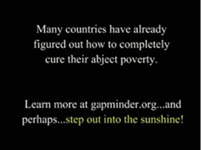
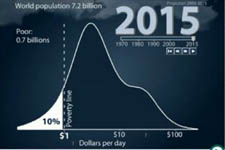
And as I watched Rosling’s dynamic analysis unfold, I kept thinking about the Seven Digital Divide Fallacies from Digital Divide.org
Those involved in the ten-year effort to close the Digital Divide were all well-intentioned. But we were like blind men describing the elephant as a tusk or a hoof rather and missing the point about the whole elephant. Similarly, closing the Divide turned out to be not a matter of gaining access to computers or cell phones but finding room for both. It is not a matter of promoting personal use of gadgets vs. shared use of gadgets but both. It is not a job for business or government but both. Not about choosing open source software over Windows but both. Similarly, it is not about GSM wireless vs. CDMA but both. Not about bottom-up vs. top-down efforts but both.
Pessimism leads to an over emphasis on top-down efforts.
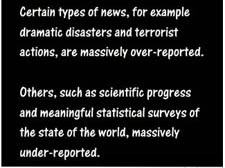
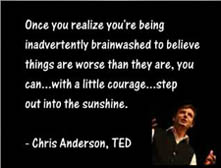
Well my own small commitment to step out into the sunshine has been to keep the conversations about technology in developing countries linked to an exploration of the development of virtual worlds. Even though the mantra, “What about issues of broadband access?” is ever present in my ears. But, as I mentioned in my last post there have been some big developments in broadband access in Africa, and elsewhere, recently, and new opportunities will emerge with this.
Rosling gives a completely new view on issues of development, poverty and health on a global scale. But, he does not look at virtual worlds! Probably, there isn’t the kind of data available for virtual worlds for this kind of analysis and projection. But, I think it would be very interesting to see some of the same interactive analysis techniques that Rosling applies to developing countries applied to virtual worlds. It might help people get a handle on some of the issues that are just too big too grasp without these kind of visual thinking tools.
What is important about virtual worlds is that they are social and immersive.
Neomeme, recently, brought both the beautiful map of the internet and the blogosphere that are at the beginning of this post to my attention. The image on the left traces links on the blogosphere – blue are reciprocal links and green are one way. Discover posted the original story which will tell you where your favorite, “jocks, gadget hounds, political junkies, and porn aficionados hangout,” and which blogs create the white hot spots. But, what struck me was how color coding the two way links blue on the map told a new and very interesting story of the blogosphere from the point of view of “active”citizenship.
[The] blue blob represents a balanced sociopolitical discourse. The prevalence of blue in this area shows that most of these links are reciprocal, suggesting a sort of metadialogue between bloggers who hurl headlines at one another. The brightest light belongs to syndicated columnist Michelle Malkin.
The dream for a metaverse that is a single coherent environment, with a single client interface and countless virtual planets is possibly emerging faster than we can imagine. In my conversation with Steve Prentice, we went over many of technology issues/obstacles concerning a stable scalable supporting ground for virtual worlds to flourish on.
Who might be the big players? Would Google with their server farm savvy, or even the giant telecoms be the big virtual world service providers one day soon? What about IBM’s announcement of building a massively scalable main frame platform using cell processors? (see discussions of this on 3pointD and eightbar.) Also see eightbar’s comments in support of Steve Prentice and Nick Price’s report from ITexpo.
I asked these questions and Steve patiently answered. But, in the end the most exciting aspect of virtual worlds is emerging regardless of uncertainties around the exact path the technologies will take. The extraordinary quality, or ROA (Return on Awsome), of virtual worlds is the new levels of collaboration and connectivity they present. I also spent time with Jonas Karlsson and Karen Arena from Xerox today and, as this was a long conversation, it is fodder for another post. But, in closing, Jonas summed things up very clearly: “To me, the main point is that these environments are immersive and social.”
Second Life, Ustream and Twitter!
As I was writing this post last night, alerted by a Twitter, I found myself watching Eric Rice stream live from Second Life to Ustream. He was interacting with a group (not to mention a bunch of vehicles!) on Second Life and with a live audience on the Ustream chat lines. It was a social mash up that really started to spin my brain on the possiblities for virtual and RL integrations. I haven’t had a chance to ask Eric about the Fed Ex van that showed up a few times in his stream also. Another interesting point, Eric Rice has decided to switch to his RL identity in Second Life despite the almost legendary status of his Spin Martin avatar. A sign, to me at least, that the linking of virtual and real worlds is happening faster than we think.
Also, thank you Aleister for introducing me to Adri at Metaversality and taking me to Wednesday night’s ” KRTU Jazz for the Metaverse.” KRTU , on 91.7 FM, provides jazz for San Antonio from Trinity University. Here’s Adri and the legendary Ella Fitzgerald – kindred spirits!
Tags: Second Life | Virtual Worlds | Virtual Reality | Twitter | Ustream | Second Life | Web 3.D | social media | social networks | global development | myths of global development | TED | gapminder | Hans Rosling | World Health | global poverty | Jazz | Ella Fitzgerald | blogosphere | internet | interweb | ROA | return on awsome | metaverse | Gartner | IT | digital divides | blogosphere | positive global development | sustainable development | Itexpo |





0 Comments For This Post
1 Trackbacks For This Post
May 3rd, 2007 at 3:22 am
[...] an earlier post, I mentioned Seven Digital Divide Fallacies from Digital Divide.org. Three of these fallacies may [...]